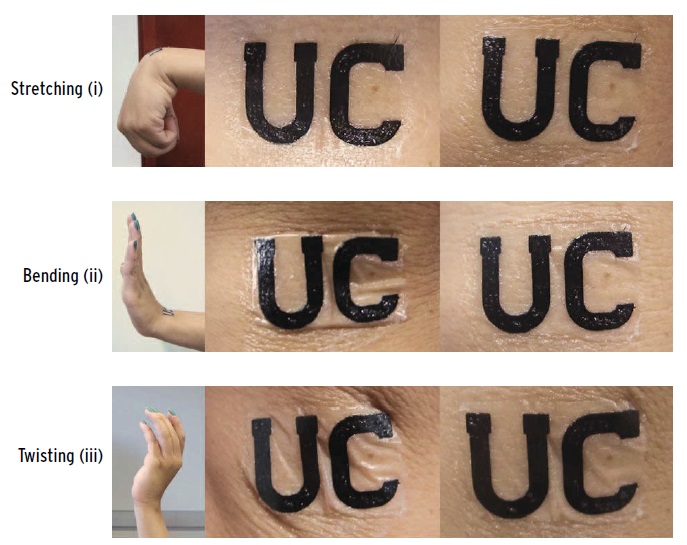A new type of tattoo
Dr. Neil Canter, Contributing Editor | TLT Tech Beat November 2014
Biofuel cell uses sweat as the fuel source to help power small electronic devices on the human body.
KEY CONCEPTS
•
A new type of biofuel cell has been developed that uses lactate as the fuel source and can be easily attached to the human body as a temporary tattoo.
•
Testing of the temporary transfer tattoo biofuel cell shows that power output was maintained at 50 percent of its original value over a four-week period.
•
Human subjects wearing the temporary tattoo experienced no discomfort, no skin irritation and no inflammatory responses when exercising with the device.
MAXIMIZING THE ABILITY TO USE ENERGY GENERATED IN A SPECIFIC PROCESS is an ongoing objective driven by the desire to optimize efficiency. Some unique approaches have been made, particularly to cultivate energy that would normally be lost such as the heat produced from an automobile’s internal combustion engine.
But finding energy sources is not reserved just to devices developed through advances in technology. In a previous TLT article, the concept of energy harvesting was discussed and an example described (
1).
Energy harvesting is defined as an attempt to utilize energy available as part of a natural process. The application described was to utilize reverse electrowetting in extracting energy derived from walking to power mobile electron devices. The objective of this approach is to capture as much of the 20 watts per foot of power lost as heat during walking as possible.
A related application is the development of biomedical devices that can be worn by an individual on the skin and used to monitor not only physiological parameters such as heart rate and blood pressure but also chemical factors such as metabolite and electrolyte changes. Dr. Wenzhao Jia, postdoctoral researcher at the University of California-San Diego in La Jolla, Calif., says, “Many types of biomedical devices have been developed, including flexible thin-film batteries, microsupercapacitors and wearable thermoelectric generators. Thin-film batteries have shown the most promise, but they can be problematic because some types, such as lithium-ion batteries, contain electrolytes that are hazardous if they leach from the battery and cause chemical burns.”
Another challenge facing researchers is how to contour a biomedical device to the human body. Jia says, “A conventional battery has a stiff surface and does not feel comfortable when placed on an individual, especially during periods of exercise.”
An intriguing source of power produced by human beings is sweat. Normally, most of us consider sweat to be an inconvenient physiological response to exercise.
If a technology could be developed to utilize human perspiration as a power source, then it might be feasible for a biomedical device to be powered in this manner to not only assess the physical fitness of an individual but also to be used to power some small electronic devices. Such an approach has now been developed.
tBFC
Jia, Joseph Wang, distinguished professor and chairperson of the nanoengineering department at the University of California-San Diego, and their associates have harnessed the energy from sweat by developing a biofuel cell that is powered by a substance found in sweat, lactate. Jia says, “During periods of exercise, the human body turns to glycolysis as a way to generate more energy needed to sustain this activity. Lactate is a by-product of glycolysis that is present in the sweat used to cool off the body. We have developed a biofuel cell that uses lactate as the fuel source. At the anode, lactate is oxidized by the enzyme, lactate oxidase to form pyruvate, while oxygen is reduced to water at the cathode.”
To deal with the problem of keeping the biofuel cell on the human body so that it is comfortable to the user and does not come off, the researchers developed a temporary transfer tattoo. They have described the technology as a temporary transfer tattoo biofuel cell or tBFC.
The anode and the cathode contain multiple components and were prepared by the use of a screen printing process. Carbon fiber reinforced carbon is the base layer for both electrodes. The carbon base on the anode was modified with lactate oxidase, while the cathode was modified with platinum black.
The anode was covered with chitosan as a protective layer, while a sulfonated tetrafluoroethylene polymer was used as a protective layer for the cathode. Figure 1 shows a tBFC with the anode in the shape of a U and the cathode in the shape of a C. Spacing between the electrodes allows the sweat to flow between the two electrodes completing the circuit.
 Figure 1. Temporary tattoo biofuel cells using lactate from sweat as their fuel source remain in place on a human body without any discomfort after a series of stretches, bends and twists. (Courtesy of University of California-San Diego)
Figure 1. Temporary tattoo biofuel cells using lactate from sweat as their fuel source remain in place on a human body without any discomfort after a series of stretches, bends and twists. (Courtesy of University of California-San Diego)
The effectiveness of the tBFC was first evaluated over a four-week period by using artificial sweat. Power output decreased by less than 10 percent over the first two-week period but maintained more than 50 percent of its original value when the test was completed.
Mechanical deformation testing was first performed
in vitro on a Gore-Tex textile through a series of stretches, bends and twists. Only a slight loss of power was observed after the first 50 tests.
The next step was for the researchers to evaluate the tBFC on human subjects. Jia says, “We organized the individuals into low fitness, intermediate fitness and high fitness groups. In one case, an individual wore the tBFC for six hours and exercised twice with a two-hour break to rest.”
The tBFCs performed well in all cases, and all human subjects reported no discomfort, no skin irritation and no inflammatory responses to the devices. Power generation was found to be dependent upon the fitness level of the individual. Higher power levels were seen with less fit individuals who needed to produce higher levels of lactate during exercise.
Removal of the tBFC from the skin is not an issue. Jia says, “It is very simple to remove the tBFC from the skin with no discomfort to the individual reported.”
The researchers believe that the tBFC has tremendous potential for future use as a power source for wearable biomedical devices. A new application just developed by the researchers is to print a BFC directly on a textile substrate such as a care label, which is easily incorporated into a headband/ wristband, and integrate the BFC with an electrical device. In this fashion, the researchers are able to directly power a LED and a digital watch. Additional information on this research can be found in two recent references (
2, 3) or by contacting Jia at
wejia@ucsd.edu.
REFERENCES
1.
Canter. N. (2011), “Powering your cell phone as you walk,” TLT,
67 (11), pp. 6-7.
2.
Jia, W., Ramirez, G., Bandodkar, A., Windmiller, J. and Wang, J. (2013), “Epidermal Biofuel Cells: Energy Harvesting from Human Perspiration,”
Angewandte Chemie International Edition,
52 (28), pp. 7233-7236.
3.
Jia, W., Wang, X., Imani, S., Bandodkar, A., Ramirez, J., Mercier, P. and Wang, J. (2014), “Wearable textile biofuel cells for powering electronics,”
Journal of Materials Chemistry A, DOI: 10.1039/C4TA04796F.
 Neil Canter heads his own consulting company, Chemical Solutions, in Willow Grove, Pa. Ideas for Tech Beat items can be sent to him at neilcanter@comcast.net
Neil Canter heads his own consulting company, Chemical Solutions, in Willow Grove, Pa. Ideas for Tech Beat items can be sent to him at neilcanter@comcast.net.